Almond: A World Class Nut
‘Almond’ is a nut and edible seed of the cultivated Prunus species. The tree plant is native to South Asia and the Middle East. It is a drupe like its cousins the cherry, peach, and apricot. Nuts are seeds and used as ‘culinary’ food that is used to snack on, cooked with other food or are used as dressings or for flavoring savory and sweet dishes. Almond is one of a world’s healthiest foods. If only we knew, we would make a part of our life. A wonder around some facts will reveal why?
Why is almond a good nut?
One of the wonderful things about almonds is that it tastes good, crunchy and gives flavor to the food. It is widely used as decorations in cakes and sweets. Almond flower is also used to make special sweet dishes in the Middle East and Indian Subcontinent.
Why is Almond Healthy?
Almond is healthy because of its various nutritive qualities along with medicinal properties. The combination of all the ingredients in a balanced combination. The understanding of the nutrient content and the qualities associated with it will convince you why almond should be added to the diet.
1. Basic Nutrients
Almond supply a substantial percentage of the daily value of basic nutrients required in a human diet. An ounce or 23-25 nuts helping provides 49% vitamins, 19% carbohydrate and protein, respectively, 13% fat, 2% minerals, and 1% fiber. Let’s see how these quantities and qualities on nutrients make it a super nut.
2. Almond is nutrient dense
Almond is a healthy nut because it is rich in major and minor nutrients. The graph shows you the density of nutrients as a percentage of the Daily Value (DV %) requirement of a person when an ounce or 23-25 nuts are taken. Plenty of copper, phosphorus, magnesium, molybdenum and manganese make up the nutrient composition. These and minor quantities of other nutrients such as selenium, fluoride give immunity to the body against many illnesses.
These fulfill 15 t0 49 % of the DV of a diet. In addition, almonds have low Glycemic Index (GI). A low GI food releases carbohydrate quite slowly leading to a gradual and stable release of energy. This results in regulation of insulin level and prevents diabetes.
The nutrients also help to maintain the bone density, ionic balance of the blood and act as antioxidants.
3. Vitamins in Almond
Vitamins make up 45% of the DV in a helping of almond. Vitamin E, a powerful antioxidant maintains the skin. The B complexes such as B6, niacin, riboflavin, thiamin, riboflavin, pantothenic acid and folic acid are essential nutrients for an optimum health condition.
4. The Beneficial Fats in Almond
An analysis of the proportion of mono, poly and saturated fat in almond shows a higher source of unsaturated fat (64%), high polyunsaturated fat (29%) and low saturated fat (7%). As fat is essential to the body for dissolving other nutrients and vitamins, unsaturated fats are recommended All foods containing fats have a varying mixture of monounsaturated and polyunsaturated fats and saturated fat.
According to the Academy of Nutrition and Dietetics a healthy diet healthy of an adult should contain fats at a range of 20-35 percent of their Daily value (DV) intake. Monounsaturated and polyunsaturated fats are known to increase the ‘good’ cholesterol or High-Density lipoprotein (HDL). Within the polyunsaturated fats, a rich source of important omega-3 essential fatty acids like Linoleic acid, a-Linolenic acid (ALA), Eicosapentaenoic acid, Docosahexaenoic acid exists in almond. This also elevates the HDL level in the blood. Being, aware of the fact that high HDL intake lowers risk of heart diseases and diabetes II, a helping of 23-25 almonds per day will suffice an adult’s requirement.
Conversely, saturated fat escalates the total blood cholesterol as well as the levels of low-density lipoprotein (LDL) cholesterol. Saturated fat is low in almonds. High LDL is a risk for cardiovascular diseases and Type II diabetes.
Due to the proportionally higher mono and polyunsaturated fat, almond is an excellent source of fatty acid essential in a diet. These act as anti-inflammatory substances preventing blood pressure, coronary diseases, brain strokes prostate, breast, and colon cancers. Omega-3 fatty acids also assist in the prevention of depression, arthritis, and Alzheimer’s disease.
5. Fiber in Almond
Almond contains 1% fiber of the DV requirement in 23-25 nut helping. Fiber is essential roughage in a diet. It helps in digestion, regulates bowel, and lowers cholesterol and blood sugar. Fiber in almonds prevents blood hemorrhage and even cancer. It rating is good among the world’s healthiest food rankings.. As it reduces the fat content of the body in maintaining low cholesterol and improving the quality of the blood profile, almonds are good in controlling obesity.
6. Other compounds in Almond
Besides almonds are full of carotenes, lutein cryptoxanthin; polyphenolic flavonoid antioxidants that protect against heart diseases, cancers, nervous diseases and many viral and fungal infections. Almonds contain l-arginine, which strengthens artery walls and prevents blood reducing the chance of heart attack. Because of its multiple properties that lead to a healthy heart almonds are known as ‘phytochemical powerhouse.’
7. Diseases Controlled by Almond
The many diseases controlled by almond is shown pictorially in the figure. this will broaden your idea of the benefits of almond for including it in the diet.
Serving Size
The U.S. Food and Drug Administration recommend 1 oz. as an average adult quota of almonds. This is equivalent a helping of 23-25 almonds and weighing 28.3 grams.
A gist about the goodness of almonds
1. Almond is one of the World’s healthiest food that help metabolic functions and sharpens the brain
2. Almonds provide ‘good’ fat, protein, fiber multiple nutrients and essential vitamins.
3. Almonds reduce the risk of coronary heart ailments and diabetes II.
4. Almonds have low calorie and low GI (gluten free) that makes it perfect for lowering LDL or ’bad’ cholesterol.
5. The medicinal properties of almond give it anti-oxidizing properties and helps control a large number of illnesses.
6. Almonds are tasty, crunchy, flavored and can eaten straight or as a culinary


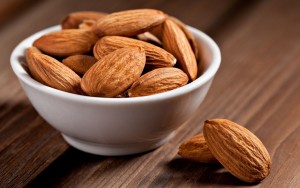
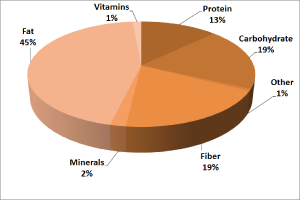
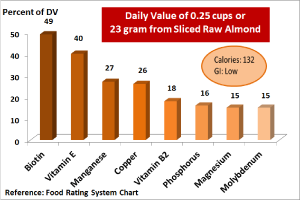
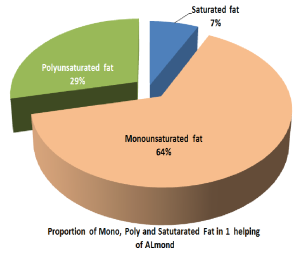
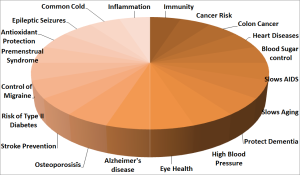



No Comments